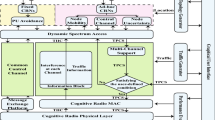Abstract
Minimization of interference to primary user (PU), maximizing the throughput and connectivity of secondary users (SUs) while providing the quality of service are the major challenges for success of an underlay mode cognitive radio network (CRN). In this work we propose a model for addressing channel sharing problem for an ad-hoc underlay CRN. The objective is to maximize the throughput of the SUs while keeping the level of interference caused to the PU by the SUs under a given PU threshold. During the underlay communication, each SU receives certain signal strength based on their distances from the PU. A head node is chosen amongst the SUs using a technique based on received signal strength by the SUs. The head collects the information from all the other SUs in terms of data rate requirement, interference produced to PU and the SNR level of the SUs through a common control channel. Using the information received a dynamic programming based model is proposed to decide which SUs can be selected to access a channel for underlay mode communication. A channel is allowed to be accessed such that the throughput of the network is maximized while the overall interference to the PU receiver is kept within the specified tolerable limit. The head node dynamically assigns the channel among the selected SUs. The efficacy of the proposed model has been evaluated with numerical evaluation and simulation study. A greedy algorithm has been formulated which selects the SUs based on their data rate to interference ratio for simulation and comparative study with the proposed model. The results show that the proposed model outperforms the greedy algorithm while increasing the overall connectivity.









Similar content being viewed by others
References
FCC. (2002). Et Docket no 02-135, spectrum policy task force (sptf) report.
Mitola, J., & Maguire, G. (1999). Cognitive radio: Making software radios more personal. IEEE Personal Communications, 6(4), 13–18.
Bhattacharjee, S., Konar, A., & Bhattacharjee, S. (2011). Throughput maximization problem in a cognitive radio network. International Journal of Machine Learning and Computing, 1(4), 332.
Verma, G., & Sahu, O. P. (2017). Throughput maximization of cognitive radio under the optimization of sensing duration. Wireless Personal Communications. https://doi.org/10.1007/s11277-017-4564-x.
Zhao, Y., Wu, J., & Lu, S. (2011) Throughput maximization in cognitive radio based wireless mesh networks. In IEEE military communications conference (MILCOM) (pp. 260–265).
Xie, S., & Shen, L. (2017). Maximum transmission capacity in cognitive radio networks. Wireless Personal Communications. https://doi.org/10.1007/s11277-017-4348-3.
Li, S., Zheng, Z., Ekici, E., & Shroff, N. (2011). Maximizing system throughput by cooperative sensing in cognitive radio networks. arXiv: 11113041v1 [csNI].
Mazloumi, L., Shahtalebi, K., & Sabahi, M. F. (2015). A simple method for throughput maximization of ofdma based CR networks. Wireless Personal Communications, 85(4), 1869–1882. https://doi.org/10.1007/s11277-015-2875-3.
Tan, L. T., & Le, L. B. (2014) Channel assignment for throughput maximization in cognitive radio networks. arXiv:14041995v1 [csNI].
Benaya, A. M., Rosas, A. A., & Shokair, M. (2017). Proposed scheme for maximization of minimal throughput in mimo underlay cognitive radio networks. Wireless Personal Communications. https://doi.org/10.1007/s11277-017-4456-0.
Moravek, P., Komosny, D., Simek, M., Jelinek, M., Girbau, D., & Lazaro, A. (2010) Signal propagation and distance estimation in wireless sensor networks. In 33rd International conference on telecommunication and signal processing, TSP 2010 (pp. 35–40).
Vu, M., Devroye, N., & Tarokh, V. (2009). On the primary exclusive region of cognitive networks. IEEE Transactions on Wireless Communications, 8(9), 3380–3385.
Haenggi, M., & Ganti, R. K. (2009). Interference in large wireless networks. Foundations and Trends in Networking, NOW, 3(2), 127–248.
Martello, S., & Toth, P. (1990). Knapsack problems: Algorithms and computer implementations. New York, NY: Wiley.
Deka, S. K., & Sarma, N. (2017). Opportunity prediction at MAC-layer sensing for ad-hoc cognitive radio networks. Journal of Network and Computer Applications, 82, 140–151.
Author information
Authors and Affiliations
Corresponding author
Additional information
Publisher's Note
Springer Nature remains neutral with regard to jurisdictional claims in published maps and institutional affiliations.
Rights and permissions
About this article
Cite this article
Hussain, A.S., Deka, S.K., Chauhan, P. et al. Throughput Optimization for Interference Aware Underlay CRN. Wireless Pers Commun 107, 325–340 (2019). https://doi.org/10.1007/s11277-019-06257-6
Published:
Issue Date:
DOI: https://doi.org/10.1007/s11277-019-06257-6




